The picture above was taken a few weekends ago when my husband and I stayed at a friend's house with two other couples, each of which has a kid roughly Mazzy's age. Charlie (Mazzy's boyfriend) is on the left and Ella (recovering bully) is on the right. Mazzy is the one in the middle who is about three seconds away from slipping backwards and hating baths forever. You'll be happy to know, I put the camera down and saved her right before her head went totally under.
What could be cuter and more innocent, we thought, then sticking all the babies in the tub together? And then, no more than two minutes in, Mazzy (the observant little devil) noticed that Charlie has a little something different going on "down there". First she pointed to it and we all giggled like children and then she reached out to touch it and we all got wide-eyed and looked at eachother like "Are there any grown-ups with answers here?" Thankfully, Mazzy's interest didn't last longer than it took us all to throw our hands up with a collective "Don't ask me!"
Apparently though, we aren't the only new parents searching for correct "Nakedness Curiousity Protocol", as evidenced by the letter below:
Dear Dr. B,
My daughter is a few months shy of two and has recently started looking and pointing at her father's penis. We have never been shy about changing in front of her and now I'm not sure if we should be acting more discreet. We want her to know that it is off-limits but not that it is bad. How do we explain?
—AB
Dear AB,
At around two-years-old, children begin to develop a sense of individuality and start exploring their bodies and noticing differences between their own bodies and those around them. This includes noticing their private parts and that they may have different body parts from their siblings or a parent of the opposite sex.
Although there is no harm in changing in front of a young child, it is important to consider the risks as well as the benefits. On one hand, being comfortable with nudity can help your child accept and take pride in their own bodies. On the other hand, some experts feel nudity is only beneficial when the child sees the body of a same-sex parent and that nudity of an opposite-sex parent after a certain age may send mixed messages about healthy boundaries and rules about sexual behavior.
If a child is engaging in a behavior that seems inappropriate or concerning, consider what aspect of the behavior is inappropriate and teach your child what she needs to know. For instance, if your child is pointing at your husband’s penis, it may be that she wants to know what it is and why she doesn’t have the same thing. Or if she is attempting to touch his penis, she may need to learn that it is okay to be curious about other people’s bodies but that private parts should be kept private and it is not okay to touch each other’s private parts.
Ignoring children’s curiosity or questions may send the wrong message and make them feel ashamed of their body. Instead, it is important to address children’s curiosity about their bodies and gender-specific body parts by explaining differences between boys and girls in a developmentally appropriate manner and by providing simple answers to questions about body parts and their functions.
For children ages two to four, it is best to be brief by simply stating that there are girl body parts and boy body parts. You may also call them private parts and explain personal boundaries such as private parts stay covered in public and we don’t touch other children’s or adult’s private parts.
At around three to four-years-old (or when your child begins potty training), begin teaching your child the actual anatomical names of body parts which will help them develop a healthy body image as well as provide them with the appropriate vocabulary needed for learning rules and boundaries to prevent embarrassment or harm such as sexual abuse.
Be careful about introducing the actual names of private parts too early or without an explanation because children may use these words in public. When children say anatomically correct names such as penis and vagina in public, there is a high likelihood that they will receive a reaction. If the reaction is overly positive (e.g., laughter) the child may say these words more frequently in public. If the reaction is overly negative, the child might feel embarrassed or ashamed.
Typically, children begin to develop a sense of modesty between 5 to 8-years-old and start to express discomfort or embarrassment about changing in public places or around certain people including family members. When children begin to develop modesty, it is best for parents to respect their privacy and this may be a good time for parents to act more discreet as well.
For children who appear to have difficulty understanding or accepting personal boundaries, you may wish to model healthy boundaries at home by showering or bathing separately and asking your child to turn around or leave the room when you change. You can also provide a verbal explanation about when it is okay to take your clothes off (in private times and places) and when it is not okay.
Always consider the unique characteristics of your child when making decisions about how and when to address their curiosity about their own and others' body parts. Providing age-appropriate information to your child about their bodies will ensure that your child will develop safe and healthy behavior as well as a secure self-image.
Hope this helps,
—Dr. B
Dr. B has a PHD in school psychology and specializes in early childhood development. If you have a question for Dr. B, please email me at myshort@mommyshorts.com.








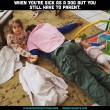




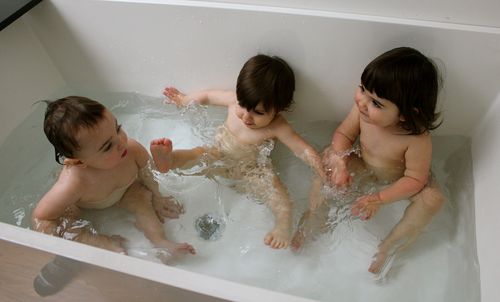
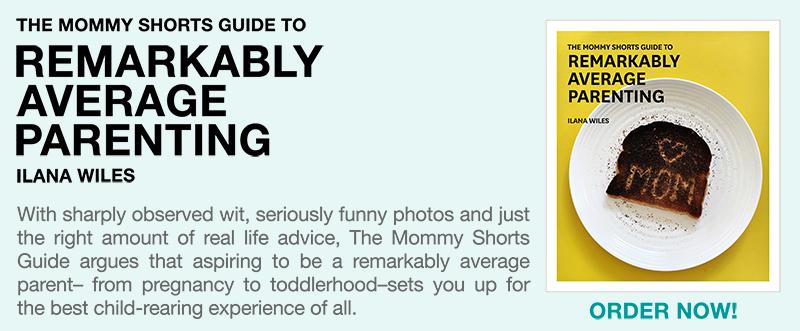
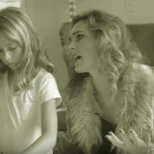
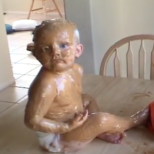
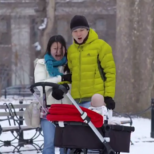

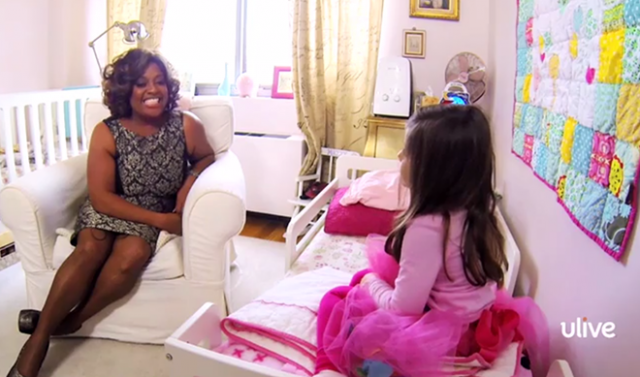






We always bathed our kids together, out of shear laziness then anything else until one day I found myself telling my daughter Grace (age 4) to please stop paying with my son, Sam’s (age 2) penis. She responded, “But he LIKES it”. She wasn’t wrong about that. Bath over. Therapy starting.
My kids are 4, 2 and 1 and like Emily they bathe together. Who has time for 3 baths? We use the right words and so far there has been no touching but there has been some giggling. I think we are okay for now but once the touching starts – so will the showers. The 2 nd 4 year old have been showering for awhile and it rocks! So fast – so easy!
Adorable picture by the way. I too have resuced my ids just moments after taking a picture and before they drowned.
I think everyone in theory knows when it is appropriate to have some modesty in front of your kids – however, as usual, the kids get in the way. In our master bath, we have sliding pocket doors that don’t lock. Therefore, my sons constantly come in while I am in the shower to leverage the time to pepper me with random questions, documentation of sibling wrongs and whining for more screen time, while I am at my most vulnerable. They even helpfully hand me my towel when I turn the water off. So our whole “let’s try to cut down on the kids seeing me unclothed” hasn’t been very successful. And any parent who has figured out how to institute privacy rules in the bathroom, please share, as my kids also sense that as an opportunity for quality time with mommy or daddy. If anyone will need therapy, it will be me.
What a great idea, to have this guest poster. Everytime I come here, I am further and further impressed.
You have so many ideas.
“I think everyone in theory knows when it is appropriate to have some modesty in front of your kid” <-- I agree with that but it's nice to see some sort of a guideline in this department. I always walk around in my bathing suit in front of both my kids. My oldest is a little boy and 22 months old. I'm not so worried about my youngest, who is a little girl, but I have been wondering lately when I should make sure to cover up in front of my son and when my fiance should make sure to cover up in front of our daughter. Thanks for the post Dr. B!
Oh my! That’s probably a story you should lock in the mommy vault and never tell them. At least until one of them gets married. Then you’ve got material for possibly the most awesome/horrifying mother of the groom/bride speech ever!
I can’t wait for showers. Something about baths always skeeves me out. I never take them myself. It’s like bathing on the floor.
I feel like Mike and I use the bathroom as an excuse to leave the other one with the kid. I am convinced that he isn’t even on the toilet but instead he’s sitting on the edge of the tub, playing with the iPad and eating a sandwich.
Dr. B is my (brilliant) sister and you will find her here every Wednesday. Feel free to email me a question for her if you have one!
This was so helpful! I love how the ages were broken down into groups. I have to admit that I’m relieved that I have two girls. I’m not nearly ready to have any sort of “please stop touching your brother’s penis” conversations. Ack! Thanks for sending this my way! Xo
Do you mean bathing suit or birthday suit? Because I have to imagine a bathing suit is always appropriate. Unless you’ve got one of those crazy cutout low plunge monokinis that only a Kardashian could pull off. If that’s the case, you may want to keep it under wraps in front of the little ones.
No problem! I read your post the other day and knew I’d be posting this today so I thought I would send it along!
I’m cracking up that Mazzy is so observant that she noticed so quickly!
My sister came to visit one time with her 4-year old son. I have a 1-year-old daughter. We put them both in the bath together. My girl kept pointing and trying to touch his you-know-what. it was like she was ringing the doorbell or something. We laughed initially, but bathtime was individual the next night… great info!
I know! That kid terrifies me with her powers of observation sometimes. We really have to watch what we say and do!
Yes— it’s all fun and games until somebody rings the doorbell…
Thank you for linking me to this, and for not letting Mazzy become traumatized from a too-soon dunking. We did that early on with Anna in a form of infant torture known as a “Christening,” aka, dunk the baby so we can go eat already.
My kids are Emily 10 robert 12 they bath together and sometimes we all bath together it’s a big bath